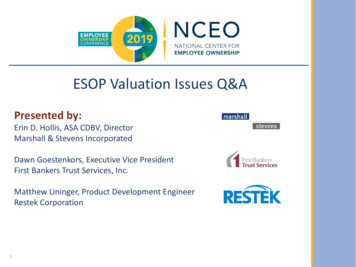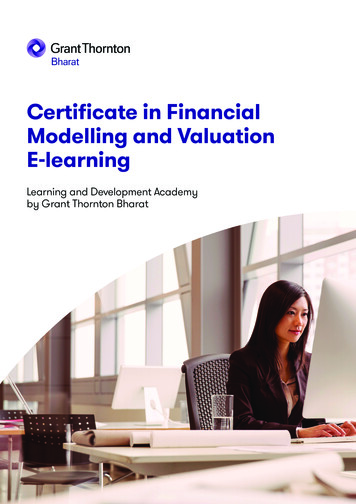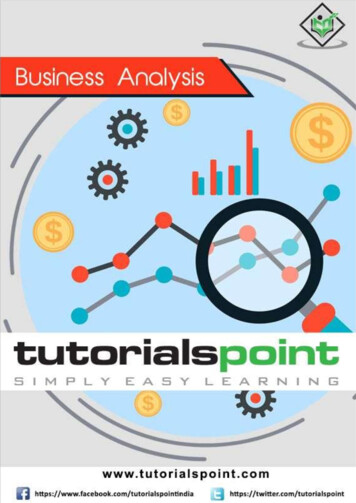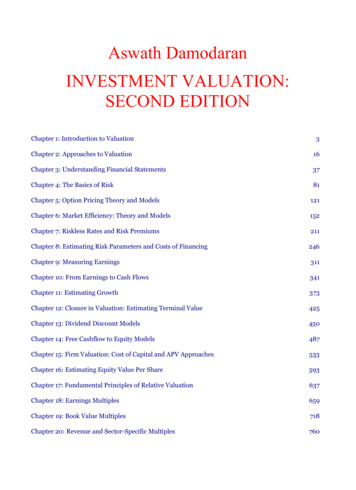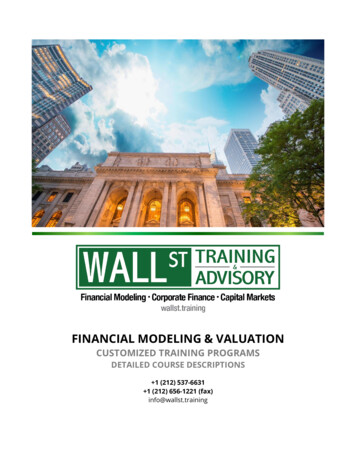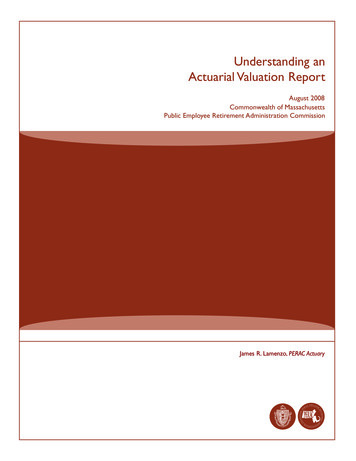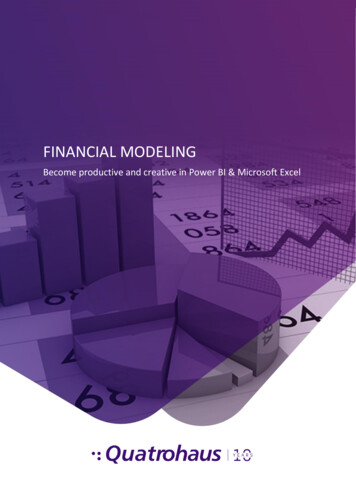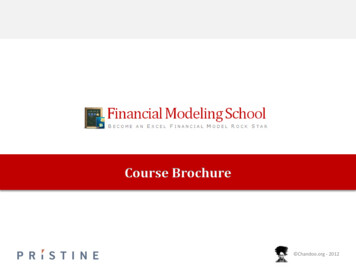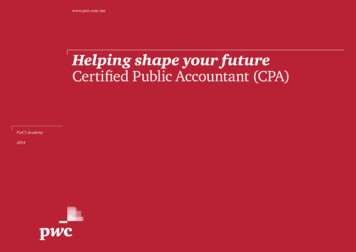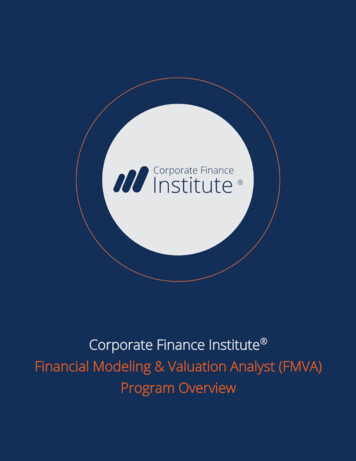
Transcription
Corporate Finance Institute Financial Modeling & Valuation Analyst (FMVA)Program Overview
Table of ContentsProgramOverviewLevel 1CoursesCFI Program in Financial Modeling & Valuation04Program Overview05Curriculum06Graduation Requirements06Optional Prerequisites07Core Courses08Elective Courses09Learning Objectives10Why Certification is Necessary12Technical Requirements13Tuition13Accounting Fundamentals14Reading Financial Statements15Fixed Income Fundamentals16Excel Crash Course17Introduction to Corporate Finance18Math for Corporate Finance19Financial Modeling Fundamentals20Financial Analysis Fundamentals21corporatefinanceinstitute.com2
Table of ContentsLevel 2CoursesLevel 3CoursesAppendixBuilding a Financial Model in Excel22Business Valuation23Budgeting and Forecasting24Rolling 12-month Cash Flow Forecast25Behavioral Finance Fundamentals26Sensitivity Analysis for Financial Modeling27Advanced Excel Formulas28Excel Dashboards & Data Visualization29Real Estate Financial Modeling30Startup / e-Commerce Financial Model31Mining Financial Model & Valuation32Financial Modeling using VBA33Advanced Financial Modeling – Mergers & Acquisitions (M&A)34Body of Knowledge35corporatefinanceinstitute.com3
CFI Program in Financial Modeling & ValuationCorporate Finance Institute (CFI) is a leading financialanalyst training company that provides career-focusedfinancial modeling and valuation courses. CFI’s courses andcertifications have been delivered to tens of thousands ofindividuals at the top universities, investment banks,accounting firms and operating companies in the world.Whether you are new to the corporate finance industry oran experienced professional, CFI training on financialmodeling and valuation will help you master new skills,achieve professional goals, and advance your career.CFI courses are designed to provide you with in-demandindustry knowledge, hands-on practice, andconfidence that will help you stand out from competitionand become a world-class financial analyst.By following CFI’s blueprint for professional success, you will learn the best practices, tools, and techniques tomaster financial modeling, company valuation, discounted cash flow (DCF) analysis, merger models (M&A),sensitivity analysis, accounting fundamentals, financial statement analysis, and much more.This professional training program will help you gain on-the-job skills and knowledge that might otherwise takeyears of hands-on experience to learn.Trained by globally experienced instructors, graduates complete our analyst program with new knowledge andskills essential for successful careers in corporate finance, investment banking, equity research, corporatedevelopment, FP&A, treasury, and accounting.43,188110 20 Students enrolled in 2017CountriesAverage years ofinstructor experiencecorporatefinanceinstitute.com4
Program OverviewReady to advance your career? Join tens of thousandsof professionals who demonstrate a commitment tothe field and dedication to continuous improvement oftheir corporate finance skills.We understand the critical importance of time inbusiness today and are pleased to offer flexible onlinetraining that allows you to complete the courses atyour own pace in a timeframe that’s convenient foryou.CFI has created a thorough step-by-step curriculumthat covers financial modeling, valuation, and financialanalysis topics — from introductory to intermediateand advanced levels (levels 1, 2 and 3).Our financial analyst training program is suitable forstudents of various professional backgrounds and isdesigned to teach you everything from the bottom up.By moving through the three levels of mastery, youcan expect to be performing industry-leadingcorporate finance analysis upon successful completionof the courses.corporatefinanceinstitute.comStart your program Become a Financial Modeling &Valuation Analyst (FMVA) Learn at your own pace, 100% onlineWhat you’ll learn: Accounting, finance, and financialanalysis Financial modeling andbusiness valuation Presentations, charts, and graphs Advanced Excel skillsWhat you’ll gain: CONFIDENCE in your career KNOWLEDGE of advanced material SKILLS for the real-world EXPERIENCE performing real analysis5
CurriculumCFI classes are offered 100% online, allowing you theflexibility to start the financial analyst program, set yourown schedule, and study at a time that’s mostconvenient for you.The analyst program includes 7 optionalprerequisites to review the fundamentals, 9 corecourses (all required) to build a strong foundation infinancial modeling and valuation, plus a minimum of 3elective courses that allow more focus on specific topicsand skills (12 required courses in total).This program will require between 50 and 100 hoursof study to master the course content and completethe exercises, quizzes and final assessments. You willlearn from a variety of methods, including recordedvideo lectures, hands-on exercises, quizzes andmultiple-choice tests.Graduation RequirementsTo be granted the Financial Modeling & Valuation Analyst (FMVA) credential from the CFI Program, studentsmust successfully complete all required and elective courses (12 in total) and demonstrate mastery of thetopics through completion of the course materials, quizzes, and assessments.Students must earn a minimum passing grade of 80% in each course assessment to complete therequirements for the program and receive certificates of completion.corporatefinanceinstitute.com6
Optional PrerequisitesCourse NameCourse CodeRecommended Study HoursAccounting FundamentalsCFI 1011-3Reading Financial StatementsCFI 1021-3Fixed Income FundamentalsCFI 1031-3Excel Crash Course for Corporate FinanceCFI 1041-3Introduction to Corporate FinanceCFI 1051-3Math for Corporate FinanceCFI 1061-3Financial Modeling FundamentalsCFI 1071-3Financial Models & Templates LibraryCFI 099N/Acorporatefinanceinstitute.com7
Core Courses (9 required)Course NameCourse CodeRecommended Study HoursFinancial Analysis FundamentalsCFI 1082-4Building a Financial Model in ExcelCFI 2012-4Business Valuation FundamentalsCFI 2022-4Budgeting and ForecastingCFI 2032-4FP&A Monthly Cash Flow ForecastingCFI 2042-4Behavioral Finance FundamentalsCFI 2052-4Scenario and Sensitivity AnalysisCFI 3012-4Advanced Excel FormulasCFI 3022-4Dashboards & Data VisualizationCFI 3032-5corporatefinanceinstitute.com8
Elective Courses (3 required)Course NameCourse CodeRecommended Study HoursReal Estate Financial ModelingCFI 3044-8Startup / e-Commerce Financial ModelCFI 3054-8Mining Financial Model & ValuationCFI 3064-8Mergers and Acquisitions (M&A) ModelingCFI 3074-8Financial Modeling with VBACFI 3082-5corporatefinanceinstitute.com9
Learning ObjectivesThe CFI Program covers a critical body of knowledge necessary for becoming a world-class financial analyst.The core curriculum for the program includes:Financial Modeling Develop industry-leading best practices for layout,design and structure of models Learn how to build a dynamically linked 3-statementmodel in Excel from scratch Create a multi-year forecast to project the incomestatement, cash flow and balance sheet into the future Use advanced Excel formulas and functions to makemodels both robust and dynamic Perform scenario analysis, sensitivity analysis,accretion/dilution analysis and other advancedmodeling practices Learn how to build models that are well designed,intelligently structured, and easy for other users to workwithValuation Learn how to value a company using comparablecompany analysis, precedent transactions, anddiscounted cash flow DCF modeling Build numerous DCF models from scratch in Exceland learn how to calculate a firm’s weightedaverage cost of capital Understand how and when to use Enterprise Valueand Equity Value multiples for valuation Learn about the pros and cons of different valuationmethods, and become proficient in all of them Arrive at a range of values for a business combiningmultiple methodscorporatefinanceinstitute.com10
Financial Analysis Learn advanced forms of financial analysis includingratios, rates of return, risk assessment, credit metrics,debt schedules, cash flow waterfalls and more Assess the overall attractiveness of investmentopportunities using financial models, scenarios, andmultiple types of analysis Develop insightful and charts and graphs for PowerPointpresentations Build Excel dashboards and use advanced datavisualization techniques Go beyond the financial model to truly understand therisks and opportunities of an investment opportunityPresentations Learn to create beautiful charts, graphs and tablesin Excel Build professional PowerPoint presentations andpitch decks Create insightful dashboards and outputs forpresentations Learn how to use data visualization to get yourpoint across Impress executives and leadership teams withdeep insights and impactful presentationsWhen you graduate from theprogram, you'll be able to: Emerge with superior CONFIDENCE andBUSINESS SKILLS Have better CAREER OPPORTUNITIESavailable to you Be more DESIRABLE in the eyes of HIRINGMANAGERS and recruiterscorporatefinanceinstitute.com11
Why Certification is NecessaryIn a highly demanding job market, it is critical for you to gain a competitive advantage through professionaldevelopment and industry-oriented certifications.As financial analysis practices and business tools evolve at an ever-increasing rate, a gap is formed betweenthe foundation provided by postsecondary institutions and the on-the-job competencies required in today’sbusiness environment.The CFI Training Program and certification were established to pick up where traditional schooling leaves offand bridge this education gap.A certification from CFI on your resume gives recognition of competence, demonstrates a commitment toongoing professional development, and helps with job advancement.corporatefinanceinstitute.com12
Technical Requirements An Internet connection is required to take this program, including the ability to play audio as courses includevoice lecturesCFI strongly suggests that students have the following technology in order to successfully complete projects andassignments online: PC or Mac Familiarity with basic Internet applications (email and web browser) A recent version of Microsoft Internet Explorer, Firefox, Chrome, Safari or another web browser An updated version of Microsoft Excel (2010 or more recent)Tuition 497 CFI FULL PROGRAM – Lifetime access to all courses – “Financial Modeling & Valuation Analyst (FMVA)”PICK AND CHOOSE – Individual courses and pricingThe CFI Program can be purchased all at once or on a course-by-course basis. All fees are in US dollars and aresubject to change.Program fees may be paid by Visa , MasterCard , PayPal, money order, certified check or wire transfer.corporatefinanceinstitute.com13
Accounting FundamentalsLEVELThis two-part series will guide you through the accounting process, exploring the layout of the balance sheet,income statement, and cash flow statement, and demonstrating how to prepare financial statements fromscratch. This course incorporates a wide range of applied exercises and case studies.MODULE 1 - CONSTRUCTING A BALANCE SHEET AND INCOME STATEMENT1.2.3.4.Explain the format of the income statement and balance sheetDefine various financial statement terms (e.g. accounts receivable, prepayments, etc.)Record financial statement transactions (e.g. invoicing, raising equity, buying inventory, etc.)Prepare a simple income statement and balance sheetMODULE 2 - CONSTRUCTING A CASH FLOW STATEMENT1.2.3.Outline the format of the cash flow statementExplain the difference between profit and cashPrepare a simple cash flow statement using the balance sheet and income statementcorporatefinanceinstitute.com14
Reading Financial StatementsLEVELIn this two-part course, we use a published set of financial statements and annual report to understand thefinancial strength of a company and help us to make informed decisions.MODULE 1 - UNDERSTANDING THE BALANCE SHEET1.2.3.Navigate successfully through the notes to the financial statementsRead and interpret the various items in a published balance sheetUnderstand complex balance sheet concepts (e.g. deferred taxes, goodwill, investments, etc.)MODULE 2 - UNDERSTANDING THE INCOME AND CASH FLOW STATEMENTS1.2.3.4.Understand the different ways to present an income statement and cash flow statementRead and interpret the various items in a published income statementIdentify the operating, financing, and investing activities of a companyDetermine what’s contained in an annual report and where to find itcorporatefinanceinstitute.com15
Fixed Income FundamentalsLEVELThis 2-part series will introduce you to the main products and players in the fixed income markets. Itillustrates the points covered using real market data and examples of the most commonly used Bloombergscreens for bonds. Core concepts such as bond pricing, duration and yield curves are covered in detail. Thiscourse incorporates a wide range of applied exercises and case studies together with quizzes to test whatyou are learnt.MODULE 1 - FIXED INCOME PRODUCTS AND MARKETS1.2.3.Learn the key features of fixed income securities & bondsUnderstand the yield curve and what it representsTrack yield curve changes throughout the economic cycleMODULE 2 - PRICING FIXED INCOME SECURITIES AND DURATION1.2.3.Use DCF to price bondsLearn the relationship between bond prices and yieldsUse duration to learn how bond prices move in the marketcorporatefinanceinstitute.com16
Excel Crash CourseLEVELLearn all the tips, tricks, shortcuts, functions and formulas you need to be an Excel power user. This course isdesigned specifically for Excel spreadsheet users who are already performing professional financial analysisand financial modeling, or are looking to prep for a corporate finance career.This free spreadsheet training course starts with the Excel basics and quickly progresses to a more advancedlevel where even experts will learn something new. We think it’s important to start at the bottom and builda solid base, which is why we review all the foundational skills you need before building more advancedspreadsheets. You’ll learn to ditch the mouse and use only keyboard shortcuts to dramatically improve yourspreadsheet building skills.In the second half of the course you’ll notice the functions and formulas getting more sophisticated and thequality of financial analysis and financial modeling becoming much higher. This half of the class focuses onfinance-specific formulas that you’d use as an analyst performing financial analysis on the job.KEY LEARNING OBJECTIVES1.2.3.4.Learn everything you need to know about Excel spreadsheets for a career in corporate financeMaster keyboard shortcuts, functions, and formulas to save time speed up your modeling skillsFollow industry leading best practices; simulates on-the-job analyst trainingStand out in an interview or move up the ladder at work by dramatically boosting your MS Excel skills andconfidencecorporatefinanceinstitute.com17
Introduction to Corporate FinanceLEVELThis introduction to corporate finance course will give an overview of all the key concepts you need for ahigh-powered career in investment banking, equity research, private equity, corporate development, financialplanning & analysis (FP&A), treasury, and much more.The course covers a wide range of topics ranging from mergers and acquisitions to various types of capitalraising. The program provides a qualitative overview of each topic, designed to give students an introductionto basic concepts, which they can explore further in our later courses.KEY LEARNING OBJECTIVES1.2.3.4.5.6.7.8.9.10.Who are the key players in the capital markets?What do the capital raising process looks like?The main business valuation techniquesTypes of valuation multiplesHow to structure a dealHow to finance an acquisitionTypes of debt securitiesTypes of equity securitiesOverview of career pathsHow to prepare for interviewscorporatefinanceinstitute.com18
Math for Corporate FinanceLEVELThis four-module course demonstrates how a number of mathematical formulas can be used to conductdetailed analysis on a set of data and/or variables.MODULE 1 - DISCOUNTED CASH FLOWS1.2.3.4.Understand the concept of the time value of moneyExplain terms such as present value, future value, NPV, DCF, annuities, and perpetuitiesUse DCF techniques to calculate present valuesCalculate the present value of cash flow streams such as annuities and perpetuitiesMODULE 2 - BOND PRICING AND YIELDS1.2.3.4.Use DCF to find the price of an annual or semi-annual bondCalculate the different yields used to assess bond returnsUnderstand the relationship between bond prices and yieldsIdentify whether a bond is trading at par, premium, or discountMODULE 3 - KEY STATISTICAL SKILLS1.2.3.Learn to calculate different measures of central tendency including arithmetic mean, weighted mean, WACC,and expected valuesCalculate simple moving and weighted moving averagesCalculate different types of statistical dispersions such as range, variance, and standard deviationMODULE 4 - COVARIANCE, CORRELATION & REGRESSION1.2.3.4.Use correlation and covariance to describe the relationship between two variablesCalculate covariance and correlation using ExcelUse regression analysis to describe the relationship between two variablesUndertake regression analysis in Excel and interpret the resultscorporatefinanceinstitute.com19
Financial Modeling FundamentalsLEVELThis four-part series provides tips and tricks for Excel model builders, gives advice on how to audit yourfinancial models, demonstrates how to use better formulas, and shows you how to monitor and handleuncertainty using scenario planning.MODULE 1 - EXCEL TIPS AND TRICKS1.2.3.Learn how to speed up your Excel modeling skills by using keystroke navigationSignificantly improve how you can edit your worksheet by learning how to use editing shortcuts in ExcelDevelop the skill every model builder needs in editing and modeling your spreadsheet in mere minutesMODULE 2 - BETTER FORMULAS1.2.3.4.Build flexibility into financial forecastsBreak down complex calculationsMinimize errors in Excel modelsUnderstand Excel function syntax performanceMODULE 3 - CATERING FOR UNCERTAINTY1.2.3.4.Learn how to perform sensitivity analysisUnderstand how data tables and goal seek can facilitate your model building processLearn how to measure the impact of future uncertainty on cash flows and profit with scenario planningLearn how to use scenario and solver tools to see how certain inputs can impact your modelMODULE 4 - AUDITING A MODEL1.2.3.Learn how to quickly and easily find errors and audit a spreadsheetUnderstand how the auditing tool-bar can help make your spreadsheet error-freeLearn how to use test data to uncover errorscorporatefinanceinstitute.com20
Financial Analysis FundamentalsLEVELThis four-module course demonstrates how you can perform a financial analysis on any organization using awide variety of ratios derived from its financial statements.MODULE 1 - ANALYZING THE INCOME STATEMENT1.2.3.Review the various components of the income statementConduct a comprehensive vertical and horizontal analysis of the income statementBenchmark income statement performance against an appropriate peer groupMODULE 2 - ANALYZING THE BALANCE SHEET1.2.3.4.5.Breakdown and define each component of the balance sheetExplain overall efficiency ratios: Total asset turnover and net asset turnover ratioExplain working capital efficiency ratios: Inventory, accounts receivable, and accounts payableDetermine how to reduce the working capital funding gap to improve operational efficienciesUndertake trend analysis to determine the overall financial performance of a company and forecast futureperformanceMODULE 3 - FUNDING THE BUSINESS1.2.3.Breakdown and understand each component of the cash flow statementUnderstand different types of debt financing tools (e.g. bonds, syndicated loans, and leasing), equity (e.g.common shares and preferred shares), and leverage ratios (e.g. debt to tangible net worth, and total assets toequity)Use real-life cash flow statements to assess the operations of a companyMODULE 4 - PYRAMID OF RATIOS1.2.3.4.Unlock the drivers of the return on equity ratioAnalyze the profitability, efficiency, and leverage ratios that make up the pyramid of ratiosUnderstand the links between the pyramid’s primary, secondary, and tertiary ratiosConstruct a pyramid of ratios using a set of published financial statements and perform a complete financialanalysiscorporatefinanceinstitute.com21
Building a Financial Model in ExcelLEVELThis four-part series guides you through how to apply a structured approach to financial modeling in Excel.It covers the many hallmarks that make financial models robust; demonstrates best practice techniques inplanning model structure; and explains how to forecast the income statement from operating revenues downto operating profit.MODULE 1 - A STRUCTURED APPROACH TO FINANCIAL MODELING1.2.3.4.Learn how to apply a structured approach to financial modeling in ExcelUnderstand the many hallmarks that make financial models robustUse best practice techniques in planning your model structureLearn how to forecast the income statement from operating revenues down to operating profitMODULE 2 - FORECASTING INCOME STATEMENT AND BALANCE SHEET ITEMS1.2.3.Use different approaches to properly forecast operating assetsLearn how to forecast property, plant, equipment, and other operating assetsLearn how to forecast various components of working capital including accounts receivable, inventories, andaccounts payableMODULE 3 - DEBT AND FINANCING SCHEDULES1.2.3.Learn how to forecast debt financing and related interest costsLearn how to forecast equity financing and dividendsUse Excel to solve circular references using both iterative and analytic approachesMODULE 4 - BUILDING A FREE CASH FLOW FORECAST1.2.3.Understand the importance of incorporating error checks in your financial modelsLearn how to derive a forecast cash flow statement based on a forecast income statement and balance sheetDerive a free cash flow statement that can be used for equity valuationcorporatefinanceinstitute.com22
Business ValuationLEVELThis four-part course provides participants with the skills needed to do a basic business valuation.MODULE 1 - VALUATION USING EQUITY MULTIPLES1.2.3.Calculate and analyze valuation using equity multiplesAppreciate the drivers of equity multiplesValue a company using equity multiples from comparable public companies and precedent transactionsMODULE 2 - VALUATION USING ENTERPRISE VALUE MULTIPLES1.2.3.Calculate various enterprise value multiplesUnderstand the drivers of enterprise value multiplesValue a business using enterprise value multiplesMODULE 3 - VALUING A BUSINESS USING DISCOUNTED CASH FLOWS1.2.3.4.Value a business using a two stage DCF valuation modelCalculate free cash flows to the firm and to equityOutline the main drivers of free cash flowsIdentify what DCF discount rate to useMODULE 4 - DETERMINING THE COST OF CAPITAL1.2.3.Calculate the cost of equity fundingCalculate the cost of debt fundingCalculate an organization’s weighted average cost of capital (WACC)corporatefinanceinstitute.com23
Budgeting and ForecastingLEVELBuild and develop budgets, forecast results, and use variance analysis to track performance. This interactiveand applied course enables participants to:1.2.3.4.Adopt a disciplined approach to developing budgetsForecast results with quantitative and qualitative methodsEffectively use variance analysis to track performancePresent results with charts and graphsWho should take this course?Those who are responsible for financial management, budgeting, and forecasting within their organizations.KEY LEARNING OBJECTIVES1.2.3.4.5.6.7.Understand the principles behind best practice financial managementExplain the importance of budgeting within a strategic frameworkBuild a robust budgeting process within their organizationKnow when and where to use various budgeting approaches such as zero-based budgetingForecast future performance by better analyzing revenue and cost driversUse effective variance reporting to track organizational performanceMake use of Excel functions and tools that are particularly suited to the budgeting process.COURSE CONTENT1.2.3.4.5.6.7.8.Budgeting within a strategic frameworkBuilding a robust budgeting processManaging budget psychologyA practical guide to developing budgetsCommon budgeting approaches (e.g. Incremental, value based, zero based, etc.)Forecasting techniques (moving average, regression analysis, etc.)Tracking budget performance with variance analysis (waterfall charts, etc.)Applied budgeting tools and techniques (Excel, solver, pivot tables, etc.)corporatefinanceinstitute.com24
Rolling 12-month Cash Flow ForecastLEVELMaster the art of building a rolling 12-month cash flow forecast model in our Financial Planning &Analysis (FP&A) course. In this course you will learn to build a cash flow model from scratch complete withassumptions, financials, supporting schedules and charts.We will look at how to forecast revenues, operating expenses and changes in balance sheet items to arrive atmonthly cash flow. From there we will assess the financial impact on the business, decide if capital needs tobe raised, evaluate credit metrics, and create elegant charts to inform management.KEY LEARNING OBJECTIVES1.2.3.4.5.6.Apply a structured approach to monthly cash flow modeling in ExcelBuild up the assumptions and formulas required to forecast the businessUnderstand how to forecast the financial statements based on the business planCalculate the monthly cash flowAnalyze the impact of the forecast on the company’s balance sheet and capitalizationOutput relevant graphs to illustrate the cash flow profile to managementcorporatefinanceinstitute.com25
Behavioral Finance FundamentalsLEVELBehavioral finance is the study of the influence of psychology on the behavior of financial practitioners. Inthis three-part course, you will learn about the wide range of decision making biases and informationprocessing errors that influence our financial decision making.MODULE 1 - DECISION MAKING BIASES AND ERRORS1.2.3.Overview of decision making biases and errorsReflective versus reflexive decision makingThe impact of overconfidence and optimism on decision makingMODULE 2 - INFORMATION PROCESSING ERRORS1.2.3.Self-attribution and hindsight biasesConfirmation and representative biasesGuarding against the narrative fallacyMODULE 3 - HOW DECISIONS ARE IMPACTED BY OTHERS1.2.3.Anchoring biasLoss aversionHerding versus independent thinkingcorporatefinanceinstitute.com26
Sensitivity Analysis for Financial ModelingLEVELThis single module advanced financial modeling course takes a deep dive into sensitivity analysis. By the endof this course you will have a through grasp of how to build a robust sensitivity analysis system into yourfinancial model.Form and function are both critical to ensure you can handle quick changes and information requests whenyou’re working on a live transaction.KEY LEARNING OBJECTIVES1.2.3.4.5.6.The importance of sensitivity analysisModel integration - Direct and Indirect methodsAnalyzing resultsPreparing a gravity sort tableUsing tornado chartsPresenting resultscorporatefinanceinstitute.com27
Advanced Excel FormulasLEVELLearn the most advanced formulas, functions and types of financial analysis to be an Excel power user. Thiscourse builds on our free Excel Crash Course and is designed specifically for spreadsheet users who arealready proficient and looking to take their skills to an advanced level.This advanced tutorial will help you become a world class financial analyst for careers in investment banking,private equity, corporate development, equity research and FP&A.Content and overview:This advanced Excel training course starts with a blank spreadsheet and quickly dives into using combinationsof functions and formulas to perform dynamic analysis.THE MAIN FORMULAS AND FUNCTIONS COVERED IN THIS COURSE1.2.3.4.5.6.7.8.INDEX and MATCHIF with AND / OROFFSET combined with other functionsCHOOSE for creating scenariosINDIRECT combined with other functionsXNPV and XIRRCELL, COUNTA and MID functions combined togetherPMT, IPMT and principal payment calculationsTHE MAIN TYPES OF DATA ANALYSIS IN THIS TUTORIAL INCLUDE1.2.3.4.5.6.Data tablesPivot tablesColumn and line chartsStacked column chartsWaterfall chartsGauge chartscorporatefinanceinstitute.com28
Excel Dashboards & Data VisualizationLEVELThis in-depth course will teach you how to build a custom Excel dashboard using professional datavisualization techniques. By the end of the course you will have a solid understanding of how to tell a story bycombining data, charts, graphs, and other visuals.Who should take this course?This Excel dashboards course should be taken by any type of financial analyst working in corporate finance.This includes financial planning & analysis (FP&A), corporate development, equity research, and investmentbanking.KEY LEARNING OBJECTIVESThis course will teach you all about the most important data visualization techniques, including:1.2.3.4.5.6.7.How to focus attentionHow to use white space effectivelyStorytelling with dataNarrative techniquesA variety of visualsHow to use affordancesStoryboardingAdditionally, this online course will teach you how to create a dashboard in Excel from scratch. The maindashboard topics covered in this class include:1.2.3.4.5.6.Page layout and designLine chartsArea chartsColumn and bar chartsGauge chartsFormatting and designcorporatefinanceinstitute.com29
Real Estate Financial ModelingLEVELBuild a dynamic Real Estate Financial Model to evaluate the investment return profile of a developmentproject in Excel.This financial modeling real estate excel cours
that covers financial modeling, valuation, and financial analysis topics — from introductory to intermediate and advanced levels (levels 1, 2 and 3). Our financial analyst training program is suitable for students of various professional backgrounds an

